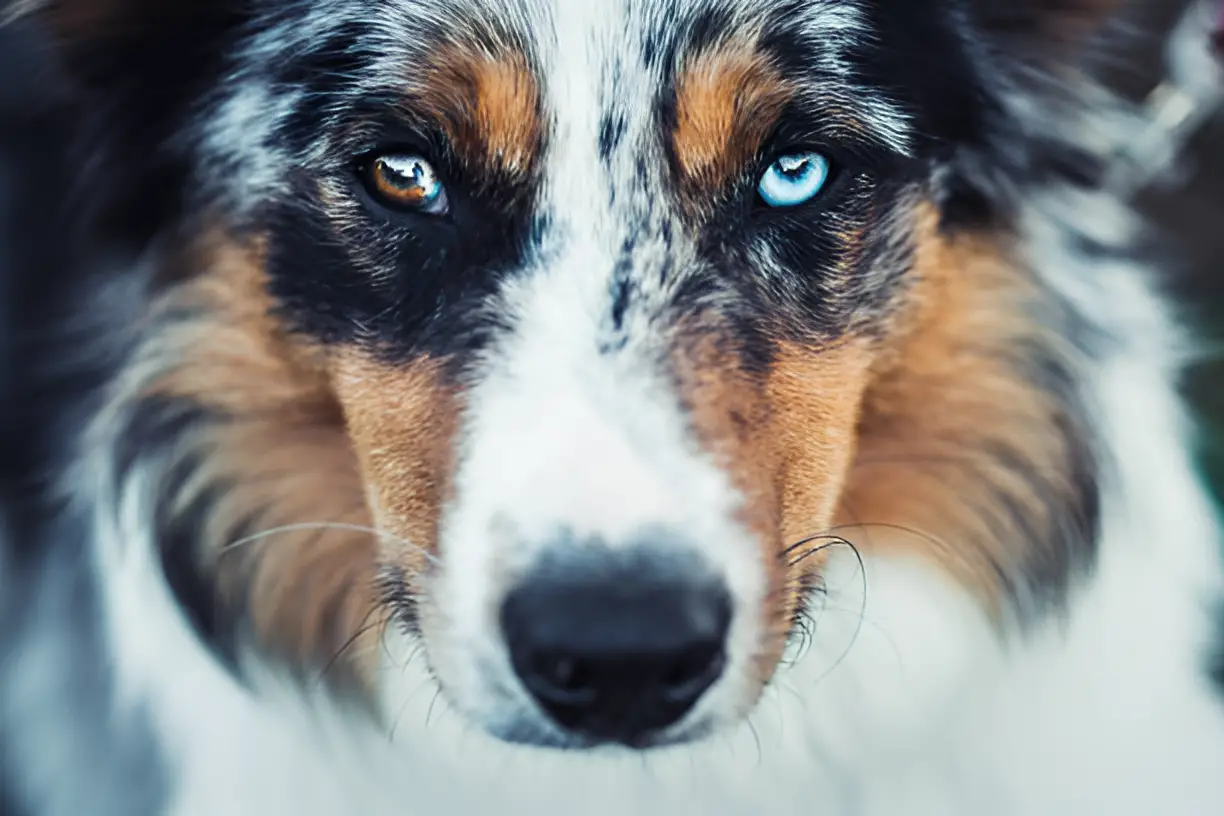No, not all merles have blue eyes; while blue eyes are common in merles, they can also have brown, amber, or even heterochromatic eyes. Merle is a fascinating and unique coat pattern found in various dog breeds, characterized by a mottled or patchy appearance. This pattern is not just about aesthetics; it also influences eye color and can have implications for a dog’s health. This comprehensive guide will delve into the genetics of the merle pattern, the variety of eye colors seen in merle dogs, and the health considerations associated with this striking coat pattern.
Understanding the Merle Gene
The merle gene is responsible for the distinctive coat pattern seen in merle dogs. It causes a dilution of the base coat color, resulting in patches of lighter and darker colors. Here are some key points about the merle gene:
Genetic Mechanism: The merle gene is a dominant gene that affects the pigmentation of the dog’s coat, eyes, and skin. It creates a marbled effect with patches of the base color and lighter areas.
Inheritance: A dog only needs one copy of the merle gene to display the merle pattern. However, breeding two merle dogs together can result in double merle offspring, which can have significant health issues.
Variability: The expression of the merle gene can vary widely, leading to different patterns and intensities of the merle coat. This variability also extends to eye color.
Eye Colors in Merle Dogs
While blue eyes are commonly associated with merle dogs, they are not the only eye color seen in these dogs. Here are the different eye colors that can occur in merle dogs:
Blue Eyes: Blue eyes are a common trait in merle dogs due to the dilution effect of the merle gene on eye pigmentation. This can result in one or both eyes being blue.
Brown Eyes: Some merle dogs have brown eyes, which can range from light amber to dark brown. The presence of brown eyes does not negate the merle pattern in the coat.
Heterochromia: Heterochromia, or having two different colored eyes, is also seen in merle dogs. This can include one blue eye and one brown eye, or even eyes with multiple colors within the same eye.
Partial Blue Eyes: Some merle dogs may have eyes that are partially blue and partially another color, a condition known as sectoral heterochromia.
Health Considerations for Merle Dogs
The merle gene, while creating a beautiful coat pattern, can also be associated with certain health issues, particularly when two merle dogs are bred together. Here are some health considerations for merle dogs:
Hearing Impairments: Merle dogs, especially double merles, are at a higher risk of congenital deafness. This is due to the lack of pigment cells in the inner ear, which are crucial for normal hearing.
Vision Problems: Merle dogs can also experience vision problems, including microphthalmia (abnormally small eyes), colobomas (defects in the eye structure), and increased sensitivity to light.
Skin Sensitivity: The areas of the coat that are lighter due to the merle gene can be more sensitive to sunlight and prone to sunburn.
Responsible Breeding Practices
To minimize the health risks associated with the merle gene, responsible breeding practices are essential. Here are some guidelines for breeding merle dogs:
Avoid Double Merle Breeding: Breeding two merle dogs together increases the risk of producing double merle puppies, which are more likely to have severe health issues. It is recommended to breed a merle dog with a non-merle dog.
Genetic Testing: Genetic testing can help identify carriers of the merle gene and ensure that breeding pairs are selected to minimize health risks.
Health Screening: Regular health screenings for hearing and vision should be conducted for merle dogs, especially those used in breeding programs.
Popular Merle Breeds
The merle pattern is seen in several popular dog breeds. Here are some breeds where the merle pattern is commonly found:
Australian Shepherd: Known for their intelligence and agility, Australian Shepherds often have striking merle coats and blue eyes.
Border Collie: Another highly intelligent breed, Border Collies can also exhibit the merle pattern, often with blue or heterochromatic eyes.
Dachshund: Merle Dachshunds, known as dapple Dachshunds, have a unique and eye-catching appearance.
Great Dane: The merle pattern in Great Danes adds to their majestic and imposing presence.
Conclusion
In conclusion, not all merles have blue eyes; while blue eyes are common, merle dogs can also have brown, amber, or heterochromatic eyes. The merle gene creates a beautiful and unique coat pattern but also comes with potential health risks, particularly when two merle dogs are bred together. Understanding the genetics, health considerations, and responsible breeding practices can help ensure that merle dogs are healthy and well-cared for. By appreciating the diversity and beauty of merle dogs, we can better care for these special companions.
The photo featured below the post headline is Credit: Hironobu Akiyama/istockphoto
I hope you find this post helpful and informative. If Yes’ feel free to share it with your friends!
Frequently Asked Questions
Do all merles have blue eyes?
No, not all merles have blue eyes. They can also have brown, amber, or heterochromatic eyes.
What health issues are associated with the merle gene?
Health issues can include hearing impairments, vision problems, and skin sensitivity, especially in double merle dogs.
How can I ensure responsible breeding of merle dogs?
Avoid breeding two merle dogs together, conduct genetic testing, and perform regular health screenings for hearing and vision.
Which dog breeds commonly have the merle pattern?
Breeds such as Australian Shepherds, Border Collies, Dachshunds, and Great Danes commonly exhibit the merle pattern.
What is heterochromia in merle dogs?
Heterochromia is a condition where a dog has two different colored eyes, which is common in merle dogs.

